Mud. Puddles. Road equipment of all types moving huge quantities of sodden soil. That’s what we witnessed as we arrived by bus in Punta Arenas from Puerto Natales in Chile. We were witnessing the damage from a recent flood when Rio de las Minas overflowed its banks after an incredible and unusual deluge (the same rainstorm that had us arriving the previous week at Hostal 4 Elementos in Puerto Natales looking like drowned rats). Our objective was to see Patagonia Sur, and the only way we could do this was to take a cruise. Yes, we swore that we’d never do it, but Cruceros Australis has a good reputation for well-organized, informal, educational and environmentally-aware boat tours, so off we went for 4 days, sailing from 53 degrees S through the Strait of Magellan to the NW Arm of the Beagle Channel and finally to Cape Horn. Our trip went through legendary lands rich in biodiversity and ancient ice and ended in Ushuaia, Argentina, the southernmost city in the world.
 Once on board, we were quickly adopted by a diverse and friendly group consisting of four couples from Sweden, Holland, Australia and the U.S. (Miami, Florida), plus a charming grandmother from France who is our age. We were part of the largest group of English-speakers on board, but there were also groups who spoke German, Italian and Spanish, as did many of our knowledgeable naturalist guides. In all, we were 105 passengers with 62 competent staff members, which seemed like a lot of people, until we remembered the cruise ships which pass by our house on Haro Strait loaded with 3000 guests.
Once on board, we were quickly adopted by a diverse and friendly group consisting of four couples from Sweden, Holland, Australia and the U.S. (Miami, Florida), plus a charming grandmother from France who is our age. We were part of the largest group of English-speakers on board, but there were also groups who spoke German, Italian and Spanish, as did many of our knowledgeable naturalist guides. In all, we were 105 passengers with 62 competent staff members, which seemed like a lot of people, until we remembered the cruise ships which pass by our house on Haro Strait loaded with 3000 guests.
.
 On the morning of our first full day we piled
On the morning of our first full day we piled into a zodiac with numerous safety instructions in our heads and our bright orange life jackets dutifully secured. We headed for Ainsworth Bay as Marinelli Glacier loomed in the background. We quietly observed a colony of basking elephant seals and watched a mock battle of two adolescents vying for some female attention. Our boatman pointed out our first condor, soaring high over a distant mountain in the Darwin Range. Our enthusiastic guide, Patricio, pointed out beautiful purple mushrooms of the Magallanes variety and then led us on a boardwalk through the damp forest to a peat bog and an incredibly green grotto. Lush textures and verdant views were everywhere, and we both went a bit wild with our camera, attempting to capture the many delightful images.
into a zodiac with numerous safety instructions in our heads and our bright orange life jackets dutifully secured. We headed for Ainsworth Bay as Marinelli Glacier loomed in the background. We quietly observed a colony of basking elephant seals and watched a mock battle of two adolescents vying for some female attention. Our boatman pointed out our first condor, soaring high over a distant mountain in the Darwin Range. Our enthusiastic guide, Patricio, pointed out beautiful purple mushrooms of the Magallanes variety and then led us on a boardwalk through the damp forest to a peat bog and an incredibly green grotto. Lush textures and verdant views were everywhere, and we both went a bit wild with our camera, attempting to capture the many delightful images.
We hiked through sun,rain, graupel, sleet, snow and wind  to the top of a mountain near Wulaia Bay and Cape Horn another day, and learned of the rampant destruction which beavers have wrought since they were introduced to Patagonia in the 1940s. We hiked up a steep path which had seven(!) beaver ponds along a little stream. The last and largest one was at the top, a tangled mess of downed and dead trees with a huge den at one end. We watched two adult beavers come and go, ignoring clicking cameras and obvious observers. Back in the early forties, the Argentine government imported fifty beavers from Canada, hoping to start a profitable fur industry. Unfortunately, there were no natural predators and this introduced species multiplied to 250,000 and are now considered a plague. The Chilean government has offered a bounty of $5.00/tail, but the overpopulation problem is far from solved. Although we haven’t seen beaver listed on any menus, the meat is supposedly offered at some Fuegian restaurants. Meanwhile, these pesky and persistent animals continue to alter the environment in many negative ways, and the Chilean government supposedly refuses to address this serious problem, stating that their top priority now is to deal with the after effects of the recent earthquake.
to the top of a mountain near Wulaia Bay and Cape Horn another day, and learned of the rampant destruction which beavers have wrought since they were introduced to Patagonia in the 1940s. We hiked up a steep path which had seven(!) beaver ponds along a little stream. The last and largest one was at the top, a tangled mess of downed and dead trees with a huge den at one end. We watched two adult beavers come and go, ignoring clicking cameras and obvious observers. Back in the early forties, the Argentine government imported fifty beavers from Canada, hoping to start a profitable fur industry. Unfortunately, there were no natural predators and this introduced species multiplied to 250,000 and are now considered a plague. The Chilean government has offered a bounty of $5.00/tail, but the overpopulation problem is far from solved. Although we haven’t seen beaver listed on any menus, the meat is supposedly offered at some Fuegian restaurants. Meanwhile, these pesky and persistent animals continue to alter the environment in many negative ways, and the Chilean government supposedly refuses to address this serious problem, stating that their top priority now is to deal with the after effects of the recent earthquake.
 At times our exploration of Tierra del Fuego turned out to be a metorologist’s dream and a photographer’s nightmare. Single and double rainbows appeared through misty conditions and intermittent sun. Winds increased and waves splashed over the bows of zooming zodiacs and the huge ship, pelting expensive lenses and their owners who were sometimes clad in marginal rain gear. Rain followed temporary clearing, and then there was more driving precipitation. Through all this the fauna seemed unperturbed. The last remaining Magallanic penguins waited patiently on rock ledges or at the shoreline until the right time arrived to dive into the water and head north for the winter. We circumnavigated one of Tuckers Islets (named for our son-in-law, of course….:) and viewed two kinds of cormorants: the Rock kind with its distinctive red markings, and the larger Imperial or King variety. When we returned to the boat from our wet excursion we learned (in an excellent bird lecture by Carlos) that we might see as many as 50 species of birds on our cruise out of the possible 430 species in Patagonia, so there were many more land, coastal and aquatic birds to come. During the rest of the trip, Val periodically went out on the windy top deck to photographs more cormorants, petrels, albatrosses, gulls and terns. Later on, a kingfisher surprised us by sitting perkily on a railing as we exited on a zodiac ramp.
At times our exploration of Tierra del Fuego turned out to be a metorologist’s dream and a photographer’s nightmare. Single and double rainbows appeared through misty conditions and intermittent sun. Winds increased and waves splashed over the bows of zooming zodiacs and the huge ship, pelting expensive lenses and their owners who were sometimes clad in marginal rain gear. Rain followed temporary clearing, and then there was more driving precipitation. Through all this the fauna seemed unperturbed. The last remaining Magallanic penguins waited patiently on rock ledges or at the shoreline until the right time arrived to dive into the water and head north for the winter. We circumnavigated one of Tuckers Islets (named for our son-in-law, of course….:) and viewed two kinds of cormorants: the Rock kind with its distinctive red markings, and the larger Imperial or King variety. When we returned to the boat from our wet excursion we learned (in an excellent bird lecture by Carlos) that we might see as many as 50 species of birds on our cruise out of the possible 430 species in Patagonia, so there were many more land, coastal and aquatic birds to come. During the rest of the trip, Val periodically went out on the windy top deck to photographs more cormorants, petrels, albatrosses, gulls and terns. Later on, a kingfisher surprised us by sitting perkily on a railing as we exited on a zodiac ramp.
Wulaia Bay, mentioned above, is the place where Fitz Roy, an English captain, and the naturalist Charles Darwin made contact with Yamana aborigines in 1834. One of five main tribal groups in Tierra del Fuego, the Yaghan or Yamana were hunters and gatherers who built lightweight and maneuverable canoes from the bark of evergreen beech trees. They mostly subsisted on fish, shellfish and marine animals such as fur seals and sea otters, and their language consisted of over 32,000 words which were recorded by a remarkable missionary priest. But the most amazing thing about this group is that they wore no clothing in their harsh climate and instead insulated their naked bodies with grease rendered from blubber . Their constant fires also kept them warm; the European sailors who named this region the “Land of Fire” did so because of the Yamana  campfires which they spotted along the shoreline. The sad story of the
campfires which they spotted along the shoreline. The sad story of the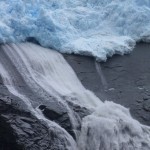 Yamana is too long and detailed to report here, but it ends with only one known survivor today from the estimated 20,000 people before Magellan. In this unique area of lonely sheep ranches, roadless forests, grey seascapes and wind-worn shores , the spirit of the Yamana remains, despite the historical tragedy of its indigenous peoples. Leslie closes with a dedication from one of our books on Patagonia, Natural Patagonia: “To the primitive inhabitants of Patagonia, those who knew how to live with nature for 13,000 years, but who disappeared in just one century….”
Yamana is too long and detailed to report here, but it ends with only one known survivor today from the estimated 20,000 people before Magellan. In this unique area of lonely sheep ranches, roadless forests, grey seascapes and wind-worn shores , the spirit of the Yamana remains, despite the historical tragedy of its indigenous peoples. Leslie closes with a dedication from one of our books on Patagonia, Natural Patagonia: “To the primitive inhabitants of Patagonia, those who knew how to live with nature for 13,000 years, but who disappeared in just one century….”
 We tried to photographically capture the extreme winds of our last day when our ship went part way around Cape Horn, and then wisely turned back. It was more than just a hair-raising experience on deck; some passengers tried to take photos while their friends and relatives held on for dear life. The captain reported
We tried to photographically capture the extreme winds of our last day when our ship went part way around Cape Horn, and then wisely turned back. It was more than just a hair-raising experience on deck; some passengers tried to take photos while their friends and relatives held on for dear life. The captain reported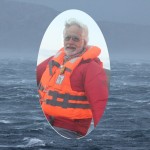 gusts up to 70 knots. Our planned excursion in zodiacs to Hornos Island,where there is a sculpture of a fractured albatross, was not to happen and we were unable to meet the lighthouse keeper’s family of four who live on this isolated island at the end of the world. Cape Horn showed us her fearful winds and our forceful memories will remain forever.
gusts up to 70 knots. Our planned excursion in zodiacs to Hornos Island,where there is a sculpture of a fractured albatross, was not to happen and we were unable to meet the lighthouse keeper’s family of four who live on this isolated island at the end of the world. Cape Horn showed us her fearful winds and our forceful memories will remain forever.
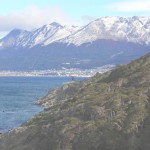 We have had a couple of ‘rest’ days in Ushuaia, Argentina, and enjoyed a six hour coast walk east along the Beagle Channel. We walked through one of the old estancias (large land grants originally for sheep farming) and looked back on little Ushuaia at the foot of overwhelming mountains. Now we are off on a 12 hour bus ride tomorrow back to Chile.
We have had a couple of ‘rest’ days in Ushuaia, Argentina, and enjoyed a six hour coast walk east along the Beagle Channel. We walked through one of the old estancias (large land grants originally for sheep farming) and looked back on little Ushuaia at the foot of overwhelming mountains. Now we are off on a 12 hour bus ride tomorrow back to Chile.
A gallery of photos taken at El Fin del Mundo!
[shashin type=”album” id=”29″ size=”small” crop=”n” columns=”max” caption=”y” order=”date” position=”center”]



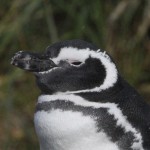

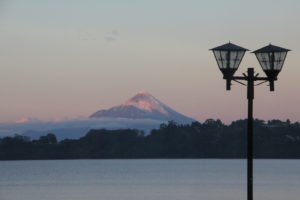
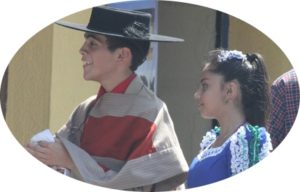
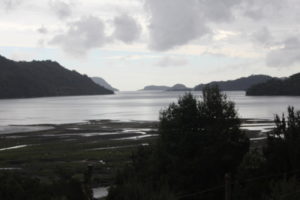
Stormy
3 Apr 2012What an adventure to be on a ship at the tip of the continent. Kudos to you both!
Ann & Johndale
12 Jun 2012Longlasting love
https://leslieval.com/2012/03/16/torres-del-paine-con-viento-furioso/